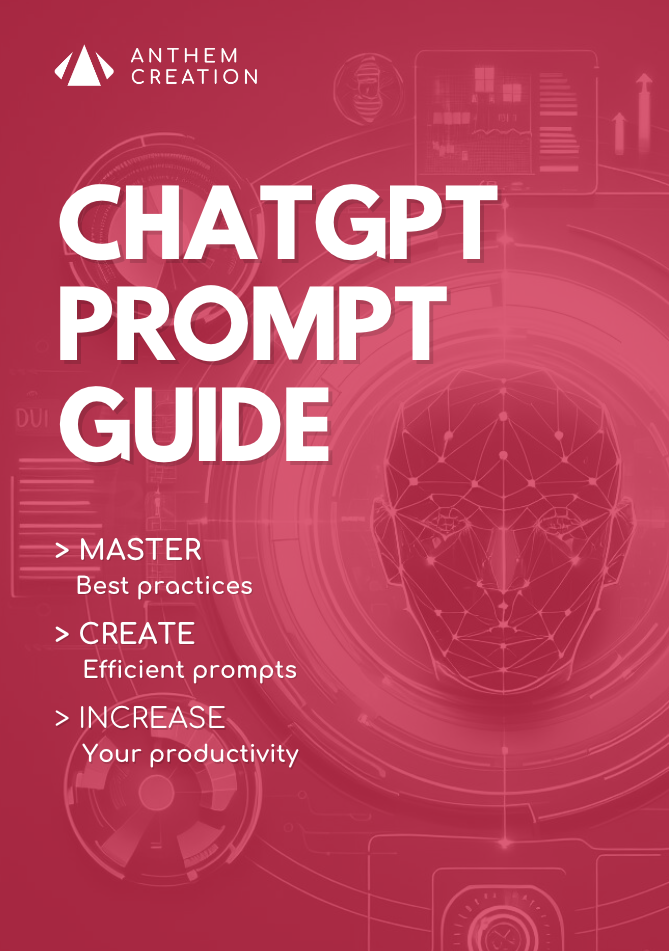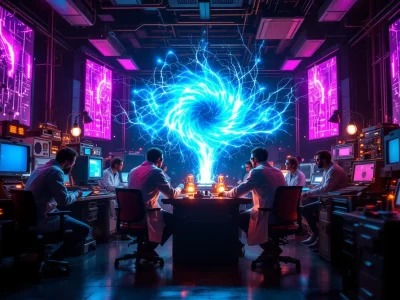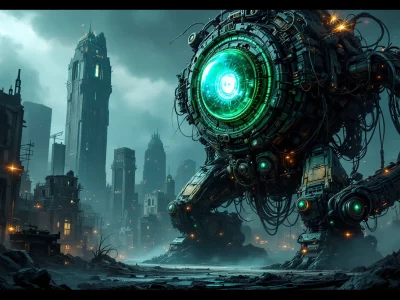Soon your computer will anticipate your needs, automatically break down your complex tasks and perform them with near-human intelligence. This is no longer science fiction… it’s the reality of 2025 with the meteoric rise of AI agents.

Beyond the simple AI assistant
AI agents may well represent the most significant innovation since the smartphone. As Cassie Kozyrkov, former Chief Decision Scientist at Google, explains:
AI agents are transforming our relationship with technology in a way comparable to what the smartphone has done for connectivity – we’re moving from tools we manipulate to partners that understand and anticipate our intentions.
But what really distinguishes an AI agent from a simple request to ChatGPT assistants or an LLM like Claude?
An AI agent operates according to a circular and iterative process. Instead of simply answering a question, it thinks, seeks, acts, evaluates its results, and then begins this cycle again until it reaches the set goal.
This methodical approach is reminiscent of how a human would approach a complex problem.
According to a recent study by MIT Technology Review, companies using AI agents see an average 37% increase in productivity on complex administrative and analytical tasks.
This gain is explained by the agents’ ability to maintain an overview while meticulously managing each step of the process.
Creating your own AI agent: a possibility available to all
The democratization of AI agents is one of the key trends of 2025. Solutions now exist for all levels of expertise:
For automators: Platforms like N8N enable AI to be integrated into existing enterprise workflows, harmoniously orchestrating interaction between different departments and tools.
For developers: Advanced APIs from OpenAI, Mistral and other vendors enable extensive customization and precise control of agent behavior.
For pioneers: Solutions like Manus AI explore the frontiers of autonomy, with agents able to take control of computers to navigate between different software and perform complex end-to-end tasks.
Find out more about the solutions available in March 2005: Creating an AI agent in 2025: Which solutions to explore?
The orchestra of intelligences: multi-agent architectures
Multi-agent architectures certainly represent the most fascinating advance.
The fundamental unit is the individual agent, defined by its specific task, its expected response, the AI model it uses and the tools at its disposal.
These agents can collaborate in a variety of configurations:
The sequential chain: As in a well-oiled assembly line, each agent processes information and then passes it on to the next.
Hierarchical structure: A supervising agent distributes tasks to specialized sub-agents, then compiles their results.
Hybrid systems: Combining hierarchy and sequence, they enable multidimensional collaboration.
Parallel processing: Several agents work simultaneously on different parts of the same problem.
Asynchronous approaches: Agents intervene at distinct times according to the needs of the project.
According to a Stanford HAI (Human-Centered Artificial Intelligence) study, multi-agent systems outperform individual agents by an average of 42% on complex tasks requiring diversified skills, such as market analysis or technical report writing.
AI agents in action: concrete use cases
The practical applications of AI agents are multiple and transformative:
In document processing, agents automatically analyze contracts of hundreds of pages, extract critical clauses and generate executive summaries.
In information retrieval, they go far beyond traditional search engines by synthesizing information from multiple sources to answer specific questions.
For human resources management, systems like Manus AI’s can evaluate hundreds of CVs in a matter of minutes, identifying the candidates that best match the skills sought and the company culture.
In real estate, they analyze the market to identify properties matching complex criteria, taking into account factors such as proximity to schools, price trends and urban development projects.
For cybersecurity, agents constantly monitor networks, detecting suspicious patterns and reacting in real time to potential threats.
A revolution comparable to the rise of SaaS
The impact of AI agents could be as profound as that of the SaaS (Software as a Service) model on the software industry. As Marc Andreessen, co-founder of Andreessen Horowitz, explains:
For every SaaS company in existence today, we’re likely to see an equivalent AI agent company emerge in the next five years.
This transformation will redefine our relationship to work. Millions of jobs centered on repetitive tasks could disappear, but new opportunities will emerge in the creation, management and optimization of these specialized agents.
For companies, being among the first to adopt these technologies could confer a decisive competitive advantage.
The superpowers of modern AI agents
Today’s AI agents possess a set of capabilities that give them remarkable power:
Monitoring: They constantly monitor their digital environment, always ready to spot the slightest important change.
Decisional Intelligence: They analyze data with advanced reasoning tools to make sound decisions.
Action Capability: They don’t just make suggestions; they can modify their digital environment to accomplish concrete tasks.
Continuous Learning: With each interaction, they enrich their knowledge and improve their performance.
Persistent Memory: Unlike traditional APIs that process each request in isolation, they retain memory of past interactions, offering a truly contextual and personalized experience.
This persistent memory is particularly revolutionary. According to Dr. Andrew Ng, founder of DeepLearning.AI:
What fundamentally distinguishes AI agents from previous AI systems is their ability to maintain a consistent context across time and interactions, just as a human collaborator would.
Four fundamental models for efficient agents
According to Andriy Burkov, author of the acclaimed “The Hundred-Page Machine Learning Book”, four essential architectures define modern AI agents:
Critical reflection: The agent examines its own results with a critical eye, identifying errors and opportunities for improvement, much like an experienced professional reviewing his or her work.
Intelligent use of tools: By accessing external resources – search engines, code execution, databases – the agent considerably extends its capabilities.
Strategic planning: the agent methodically breaks down complex tasks into logical steps and identifies the tools needed for each.
Collaborative multi-agent systems: several specialized agents work together on a project, each contributing their specific expertise, thus reproducing the dynamics of a high-performance human team.
Beyond automation: Adaptive intelligence
It’s essential to distinguish AI agents from traditional automation. As Yann LeCun, Chief AI Scientist at Meta, explains:
Classical automation follows a rigid script; AI agents, on the other hand, understand the world around them and can adapt to the unexpected.
The perfect analogy would be that of a stationary vacuum cleaner (the automation) compared to a vacuum robot (the AI agent).
The former follows a predetermined path, while the latter analyzes its environment, detects obstacles and adjusts its strategy accordingly.
This ability to adapt is made possible by the integration of large language models (LLMs) which serve as reasoning engines.
These models enable agents to understand natural language, solve complex problems and represent knowledge in a nuanced way.
Current technical limitations
Despite their extraordinary potential, the development of AI agents comes with significant challenges:
The calibration of autonomy remains a tricky issue. As Timnit Gebru, founder of the DAIR Institute, points out:
The question is not simply how much autonomy to give AI agents, but how to structure that autonomy so that it truly serves human interests.
The implementation of effective safeguards is crucial to ensure that agents act in accordance with set objectives and ethical values.
The management of complexity in multi-agent systems represents a major technical challenge, as interactions between agents can become unpredictable as their number increases.
The skills of prompt engineering – the art of formulating clear and effective instructions for AIs – are becoming a valuable expertise.
Start exploring these new tools
The year 2025 marks a decisive turning point in the democratization of AI agents. Whatever your expertise or ambitions, suitable solutions exist.
Whether you’re a novice or an expert, there are tools to explore and integrate advanced technologies. N8N is ideal for automation professionals looking to integrate these technologies gradually. Demanding developers can use advanced APIs for precise control. Finally, solutions like Manus AI invite visionaries to push back the boundaries of what’s possible.
The AI agent revolution has only just begun, but it already promises to profoundly transform the way we work, interact with technology and solve complex problems.
AI NEWSLETTER
Stay on top of AI with our Newsletter
Every month, AI news and our latest articles, delivered straight to your inbox.

CHATGPT prompt guide (EDITION 2024)
Download our free PDF guide to crafting effective prompts with ChatGPT.
Designed for beginners, it provides you with the knowledge needed to structure your prompts and boost your productivity
With this ebook, you will:
✔ Master Best Practices
Understand how to structure your queries to get clear and precise answers.
✔ Create Effective Prompts
The rules for formulating your questions to receive the best possible responses.
✔ Boost Your Productivity
Simplify your daily tasks by leveraging ChatGPT’s features.
Similar posts
Creating an AI agent in 2025: Which solutions to explore?
The AI agent revolution is in full swing in 2025, offering enthusiasts and professionals alike a multitude of options for building autonomous intelligent assistants. This guide presents an overview of …
Deep Research : The AI agent that carries out complex searches in record time
Deep Research from OpenAI presents itself as a major breakthrough in the field of AI agents. It’s not just another tool, but a true AI agent capable of conducting in-depth …
OpenAI Operator vs Anthropic Computer Use: The battle of the AI agents
Artificial intelligence continues to revolutionize the way we interact with computers. Two giants stand out in this technological race: OpenAI, with its AI agent named Operator, and Anthropic, with its …


